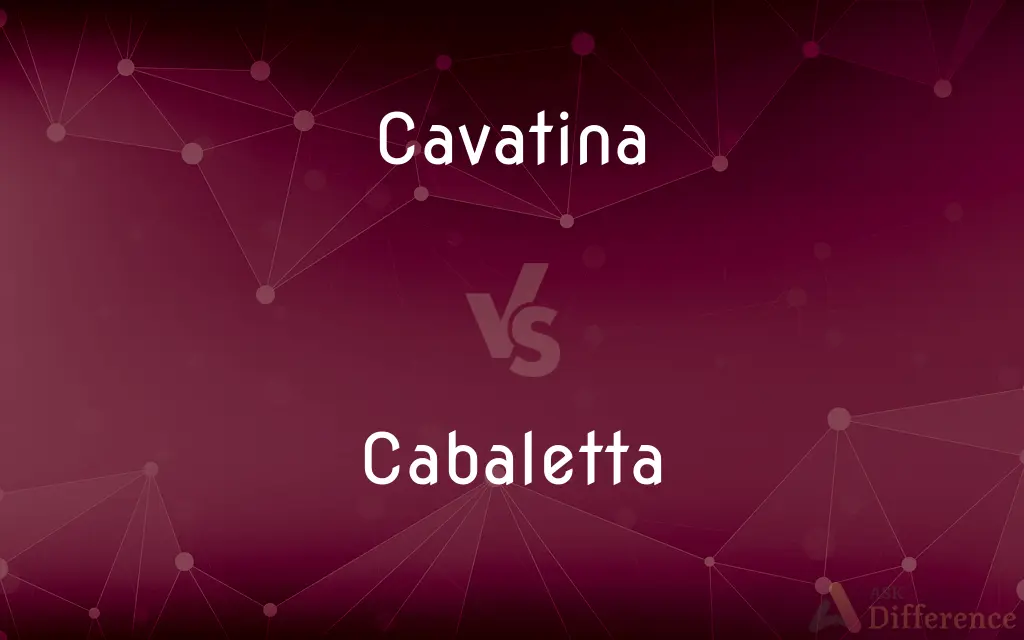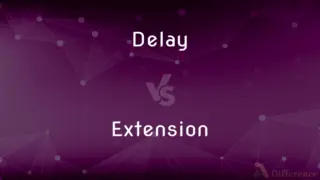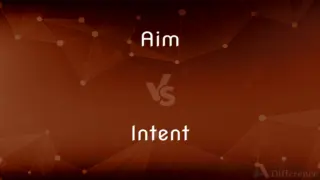Cavatina vs. Cabaletta — What's the Difference?
By Tayyaba Rehman & Fiza Rafique — Updated on March 29, 2024
Cavatina is a simple, melodic instrumental or vocal piece, often part of an opera. Cabaletta features a fast, lively tempo, usually following a slower section in operas.

Difference Between Cavatina and Cabaletta
Table of Contents
ADVERTISEMENT
Key Differences
Cavatina is a term that denotes a short, simple melody performed as a song or instrumental piece, often found within the larger context of an opera or a sonata. It's characterized by its lyrical simplicity and emotional depth, serving to express a moment of introspection or a deep feeling without the complexity of a full aria. On the other hand, a cabaletta is a specific type of operatic aria, typically brisk and lively, that usually follows a more reflective, slower section known as the "cantabile." The cabaletta's purpose is to showcase the singer's virtuosity through rapid-fire notes and a spirited tempo, often culminating in a dramatic climax.
Cavatina, by its nature, is designed to focus on the melodic line, often devoid of extensive ornamentation, allowing the beauty of the melody itself to shine through. This simplicity and clarity make it a poignant moment in an opera or a chamber piece. Whereas the cabaletta is all about energy and excitement, designed to leave the audience exhilarated, it often features repetitive lines and a predictable structure, which helps in building momentum and showcasing the agility of the singer's voice.
In terms of structure, a cavatina is usually straightforward, consisting of a single section without repeats, emphasizing emotional expression over technical display. This contrasts with the cabaletta, which often adheres to a strict form, with a repeated section that accelerates in pace and intensity, emphasizing technical skill and stamina.
The emotional content of a cavatina is often introspective, reflecting a moment of inner turmoil or profound contemplation within the narrative of an opera. It provides a window into the soul of the character, conveying their deepest thoughts and feelings in a direct and unadorned manner. Conversely, a cabaletta is typically more outward-looking, conveying decisive action, resolution, or defiance. It is a vehicle for the character to express determination, joy, or defiance, often leading to a pivotal moment in the story.
The use of cavatina and cabaletta within the operatic structure also differs. A cavatina might appear as a standalone piece or as part of an extended aria, serving as a moment of reflection before the drama progresses. On the other hand, a cabaletta usually follows a cantabile section in a two-part aria, with the cantabile-cabaletta pair creating a dynamic contrast that highlights the emotional journey of the character and propels the narrative forward.
ADVERTISEMENT
Comparison Chart
Definition
A short, simple, melodic piece in opera or instrumental music.
A fast, lively aria in opera, following a slower section.
Tempo
Generally slow to moderate, focusing on lyrical expression.
Fast, with a lively tempo emphasizing virtuosity.
Emotional Tone
Introspective, expressing deep feelings or contemplation.
Energetic, often conveying excitement or resolution.
Structure
Simple, often without repeats, focusing on melody.
More structured, with repeats, highlighting agility.
Purpose
To express a moment of deep emotion or reflection.
To showcase vocal or instrumental virtuosity and energy.
Compare with Definitions
Cavatina
A short, lyrical piece of music, often without many embellishments.
The cavatina in the opera provided a moment of serene beauty amidst the drama.
Cabaletta
A brisk, lively piece of music, typically part of an opera.
The soprano's rendition of the cabaletta was breathtaking.
Cavatina
A simple melody suitable for vocal or instrumental performance.
The composer's new work features a cavatina that captures the heart.
Cabaletta
A showcase for technical skill in opera.
The cabaletta demands a high level of vocal prowess and stamina.
Cavatina
A piece often found in operas, sonatas, or quartets.
The string quartet's cavatina moved the audience to tears.
Cabaletta
Part of the aria structure, following a slower cantabile.
The transition from cantabile to cabaletta was executed flawlessly.
Cavatina
An expressive musical moment that conveys deep emotion.
The cavatina became the most memorable part of the performance.
Cabaletta
An aria characterized by a fast tempo and virtuosic vocal lines.
The cabaletta showcased the singer's incredible range and agility.
Cavatina
A standalone musical form focusing on melodic beauty.
The cavatina is frequently performed at recitals for its emotional depth.
Cabaletta
A piece designed to energize and excite the audience.
The cabaletta brought the crowd to its feet with its vivacity.
Cavatina
Cavatina is a musical term, originally meaning a short song of simple character, without a second strain or any repetition of the air. It is now frequently applied to any simple, melodious air, as distinguished from brilliant arias or recitatives, many of which are part of a larger movement or scena in oratorio or opera.One famous piece that bears the name, although without words, is the 5th movement of Beethoven's String Quartet in B-flat major, Opus 130.
Cabaletta
Cabaletta is a two-part musical form particularly favored for arias in 19th century Italian opera in the belcanto era until about the 1860s during which it was one of the era's most important elements. More properly, a cabaletta is a more animated section following the songlike cantabile.
Cavatina
(music) An operatic song in slow tempo, either complete in itself or (e.g., in Bellini and Verdi) followed by a faster, more resolute section: hence
Cabaletta
A short aria that has a repetitive rhythm and a simple style.
Cavatina
(music) A rather slow, song-like instrumental movement; the title, for example, of a movement in Beethoven's string quartet in B flat, op. 130 (1826) and of a once-famous piece (originally for violin and piano) by Raff, and of the slow movement of Rubra's string quartet No. 2.
Cabaletta
The final section of an aria or duet marked by a quick uniform rhythm.
Cavatina
Originally, a melody of simpler form than the aria; a song without a second part and a da capo; - a term now variously and vaguely used.
Cabaletta
A short, rhythmically repetitive aria.
Common Curiosities
What is a cavatina?
A cavatina is a short, melodic piece of music, often part of an opera or instrumental work, known for its simplicity and emotional depth.
Can a cavatina have lyrics?
Yes, a cavatina can have lyrics, especially when it's part of an opera or a vocal piece.
What characterizes a cabaletta?
A cabaletta is characterized by its fast tempo, lively rhythm, and is typically part of an opera, showcasing vocal virtuosity.
What is the purpose of a cabaletta in opera?
The purpose of a cabaletta is to showcase the singer's technical skill and to inject energy and excitement into the narrative.
How does a cavatina differ from an aria?
A cavatina is generally simpler and shorter than an aria, focusing more on melodic expression than on dramatic intensity.
Can instrumental music have a cavatina?
Yes, instrumental music can feature a cavatina, often as a standalone piece or part of a larger work, emphasizing melody and emotion.
What makes a cabaletta exciting?
The excitement of a cabaletta comes from its rapid pace, virtuosic demands, and the energetic climax it often provides.
Is a cavatina always slow?
While not always slow, cavatinas are typically moderate in tempo, prioritizing emotional and lyrical expression.
How is a cabaletta structured?
A cabaletta is structured with a fast tempo and often includes repeats, designed to highlight the singer's vocal agility.
Do all operas contain cavatinas and cabalettas?
Not all operas contain cavatinas and cabalettas, as their inclusion depends on the composer's stylistic choices and the opera's structure.
Share Your Discovery

Previous Comparison
Delay vs. Extension
Next Comparison
Aim vs. IntentAuthor Spotlight
Written by
Tayyaba RehmanTayyaba Rehman is a distinguished writer, currently serving as a primary contributor to askdifference.com. As a researcher in semantics and etymology, Tayyaba's passion for the complexity of languages and their distinctions has found a perfect home on the platform. Tayyaba delves into the intricacies of language, distinguishing between commonly confused words and phrases, thereby providing clarity for readers worldwide.
Co-written by
Fiza RafiqueFiza Rafique is a skilled content writer at AskDifference.com, where she meticulously refines and enhances written pieces. Drawing from her vast editorial expertise, Fiza ensures clarity, accuracy, and precision in every article. Passionate about language, she continually seeks to elevate the quality of content for readers worldwide.
















































